ALLERGIES IN DOGS & CATS
- By Admin
- •
- 26 Aug, 2017
- •
Few problems can be as frustrating for pet owners (and veterinarians) to deal with as allergies. For dogs and cats the itchy feeling can cause severe irritation and self-mutilation. Treating allergies can be as simple as an effective flea control. However, in severe cases obtaining complete control of allergies can be elusive and necessitate multiple treatments. It is almost always a lifelong problem and can be expensive to control.
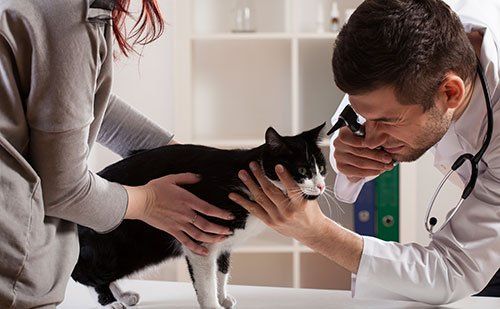
It is felt that if a dog or cat has an allergy to one thing then to some degree they are allergic to many things. The primary causes for allergies are fleas, environmental and food.
Corticosteroids generally control Atopy but long-term use is associated with undesirable side effects. Newer immune system modulating drugs such as Apoquel® (oclacitinib) and Atopica® (cyclosporine) can also be effective with Apoquel generally effective in reducing the itch resulting from Atopy and/or food allergy. Both medications can also have long-term side-effects which need to be monitored for. For Atopic dogs an injectable monoclonal antibody (Cytopoint ™) that blocks the protein Interleukin-3/ that results in the itch is highly effective and safe. Long-term therapy is best done with multiple therapies including immunotherapy based on blood or skin allergy testing, antimicrobial therapy with shampoos and other topical products and skin barrier therapy with topical products and essential fatty acid supplementation.
Food allergies are treated by avoiding the offending food allergens. While beef, poultry, chicken and wheat are commonly implicated, the adverse reaction can be to any food or food additive. There is no accurate blood test. To make a definitive diagnosis, one must feed a dietary trial for 3 months and if improvement is seen, then feed the former diet to see an adverse response. While a home-prepared diet is best, prescription veterinary diets are easier but no single one will work all the time. Usually improvement will be seen in 4-5 weeks but if no improvement is seen in 12 weeks, then try another. 100% compliance is essential and this means no treats, table food and flavored medications. All skin infections need to also be eliminated by the end of the trial, as a common complication with any allergy is skin infections.
Allergies are a lifelong problem and tend not to just go away. When dealing with allergies a systematic and disciplined approach is key. Trying a little of this or that generally is ineffective and leaves one frustrated and having to start all over again. Patience is needed. While “flare ups” will likely occur, allergies can be controlled by a systematic approach and close monitoring by your veterinarian.
- Flea allergies are a reaction to flea saliva.
- Environmental allergies include dust mites, grasses, weeds and trees.
- Food allergies can be due to many different dietary ingredients.
Sorting out which allergy or combination of causes is responsible for a pet’s itchy feeling is best done in a strict, systematic approach. The location of biting, chewing, rubbing, etc. can be helpful as well as the breed, age and if it is a seasonal problem. The possibility of mites cannot be overlooked and at least a cursory evaluation for mites needs to be done first. Bacterial and malassezial (a yeast) infections can mimic allergies and are a frequent complication of the biting and chewing associated with allergies. These infections need to be controlled and kept under control when dealing with allergies.
The easiest allergy to control is an allergic reaction to flea saliva. Even the bite of one flea can cause an allergic reaction. Effective flea control on all dogs and cats in the household will control this allergy. Unfortunately, many products claim to be effective but are not. Consult with your veterinarian.
Environmental allergies (Atopy) and food allergy symptoms are similar and distinguishing between the two can be difficult. In dogs both can cause rubbing or scratching at the face, chewing the paws and recurrent ear infections. While food allergies generally start at less than 1 year of age or older than 5 years, Atopy generally starts between 6 to 3 years of age. Atopy can be seasonal at least at first while food allergy symptoms are usually year round. In cats Atopy and food allergies are much less common than flea allergy and occur with equal frequency and without an unique pattern.
Corticosteroids generally control Atopy but long-term use is associated with undesirable side effects. Newer immune system modulating drugs such as Apoquel® (oclacitinib) and Atopica® (cyclosporine) can also be effective with Apoquel generally effective in reducing the itch resulting from Atopy and/or food allergy. Both medications can also have long-term side-effects which need to be monitored for. For Atopic dogs an injectable monoclonal antibody (Cytopoint ™) that blocks the protein Interleukin-3/ that results in the itch is highly effective and safe. Long-term therapy is best done with multiple therapies including immunotherapy based on blood or skin allergy testing, antimicrobial therapy with shampoos and other topical products and skin barrier therapy with topical products and essential fatty acid supplementation.
Food allergies are treated by avoiding the offending food allergens. While beef, poultry, chicken and wheat are commonly implicated, the adverse reaction can be to any food or food additive. There is no accurate blood test. To make a definitive diagnosis, one must feed a dietary trial for 3 months and if improvement is seen, then feed the former diet to see an adverse response. While a home-prepared diet is best, prescription veterinary diets are easier but no single one will work all the time. Usually improvement will be seen in 4-5 weeks but if no improvement is seen in 12 weeks, then try another. 100% compliance is essential and this means no treats, table food and flavored medications. All skin infections need to also be eliminated by the end of the trial, as a common complication with any allergy is skin infections.
Allergies are a lifelong problem and tend not to just go away. When dealing with allergies a systematic and disciplined approach is key. Trying a little of this or that generally is ineffective and leaves one frustrated and having to start all over again. Patience is needed. While “flare ups” will likely occur, allergies can be controlled by a systematic approach and close monitoring by your veterinarian.

There is currently a confirmed local outbreak of H3N2 canine influenza. Reports of influenza cases began around 01/10 and significantly increased in number 01/15. Cases have been reported primarily from San Jose, Campbell and Sunnyvale.
The H3N2 strain of influenza Type A was first seen in the U.S. in Chicago in 2015. The virus is highly contagious and dogs can have mild symptoms that may be mistaken as so called “kennel cough” or more severe symptoms resulting in fever and pneumonia.

Holiday time presents some situations which can be hazardous to your pet’s health. A little planning and taking extra precautions will keep the holidays a happy time for everyone.
Holiday food favorites can be dangerous for dogs watch out for “counter surfing” with food left on counters and serving areas. Fats, gravies and poultry skin can lead to gastrointestinal upset or worse pancreatitis. This inflammatory condition of the pancreas often requires hospitalized care and can be fatal. Keep trash where your pet cannot get to it. Food scraps and packaging can be delectable for your pet.

Inflammation within the joints, osteoarthritis, is common in dogs with about 20% suffering the effects. It is a slowly evolving disease with development of joint pain, stiffness and limitation of motion. The most common cause is abnormal stresses on normal cartilage. Even tiny imperfections in the joints can lead to mechanical breakdowns and the resultant inflammation. The progression of the disease can be affected by body weight, amount of exercise and genetic influences.
The first symptom is loss of normal performance followed by stiffness after rest that usually lasts only a few minutes. Next, quality of life is affected – decreased exercise tolerance, not getting in or out of the car without help and decreased activity. These problems are frequently blamed on the pet’s increasing age. Progressive disease leads to lameness of a sudden or slow development. In some dogs there may be behavioral effects of joint discomfort including nervousness, aggression, depression and loss of appetite.

Superficial shell abscesses and erosions, or shell rot as it is often called, is a common problem in aquatic chelonians. The keratin scutes that cover the bony shell develop defects or develop dark, pale or pink discolorations. The problem usually occurs as a result of infrequent water changes, lack of a filtration system, filtration system not cleaned and/or too low an environmental temperature.
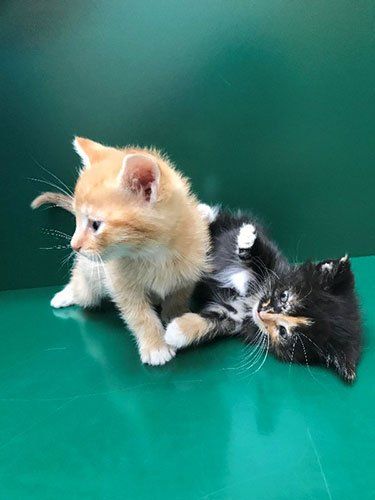
Miramonte Veterinary Hospital has been working with various rescue organizations to help kittens/cats and the occasional rat or rabbit find their permanent home. We do not receive any support or funding but do this as our contribution to the community.
Kittens ready to go to their new home:
Lemon Meringue: ~ 8 weeks old, male, castrated
Chocolate Banana Cream: ~ 8 weeks old, female, spayed
Lemon Meringue: ~ 8 weeks old, male, castrated
Chocolate Banana Cream: ~ 8 weeks old, female, spayed
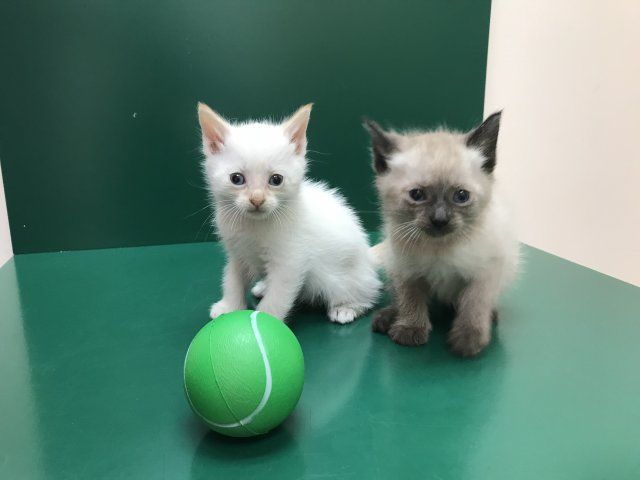
Miramonte Veterinary Hospital has been working with various rescue organizations to help kittens/cats and the occasional rat or rabbit find their permanent home. We do not receive any support or funding but do this as our contribution to the community.
Kittens ready to go to their new home:
Coconut Cream: ~ 8 weeks old, male, castrated
Chocolate Mousse: ~ 8 weeks old, male, spayed
Coconut Cream: ~ 8 weeks old, male, castrated
Chocolate Mousse: ~ 8 weeks old, male, spayed
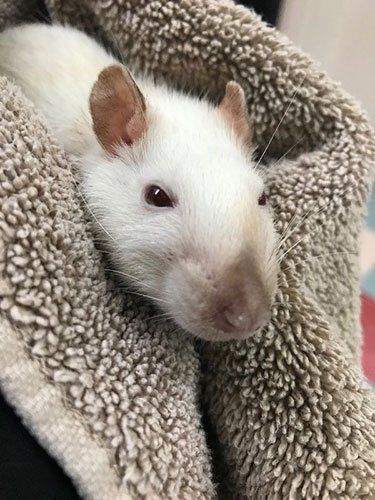
Miramonte Veterinary Hospital has been working with various rescue organizations to help kittens/cats and the occasional rat or rabbit find their permanent home. We do not receive any support or funding but do this as our contribution to the community.
Vanilla Bean is a female rat who has been spayed. She loves to sit on your lap. She is ready to be yours!
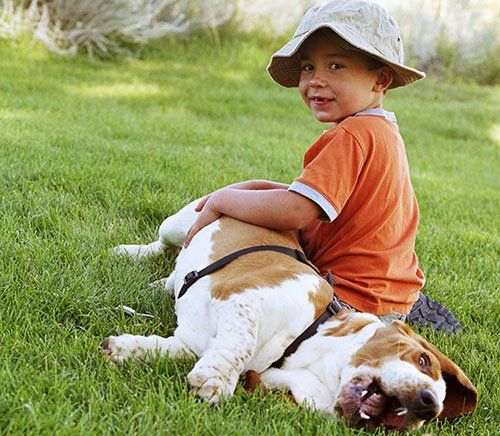
The weather here is as perfect as it gets for being outdoors at any time of day and any day of the year. So when warm weather comes the effects on our pets can come as a surprise especially on a midday hike in the hills or traveling to a warmer area. The effects of heat stroke can come quickly and mortality is 50%.
Heatstroke occurs when the body is generating more heat that it can get rid of. Short-nosed breeds of dogs, obese dogs, older dogs and those with upper airway or heart disease have more difficulty regulating body temperature. Nervous and excitable dogs along with those being excessively exercised are also at risk. Signs of heat stroke may begin with excessive panting and appearing distressed and becoming restless. Large amounts of saliva may come out of the mouth and/or nose. Weakness and difficulty in standing may then occur and you may notice gums looking bright red or purple/blue.
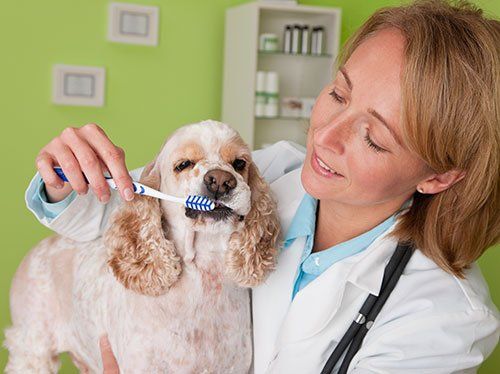
Well-meaning pet owners can be quite surprised when their pet requires multiple tooth extractions when they have regularly had non-professional dental scaling done. The primary reason is that removal of dental tartar on the visible surfaces of the teeth is not enough. The effect is purely cosmetic. Tartar under the gum line within the gingival pocket can only be removed under anesthesia and left on the teeth will contribute to periodontal disease. Periodontal disease starts with inflammation of the gums (gingivitis) and can lead to periodontitis which is loss of the tooth supporting tissues. Most small breed dogs have periodontal disease by 3 years of age. Untreated dental disease especially where extractions are needed is painful for your pet. Many times pet owners have commented on how much more active and engaging their pet is after dental treatment.






